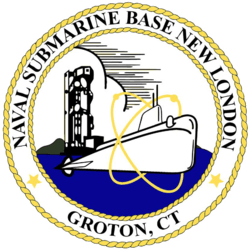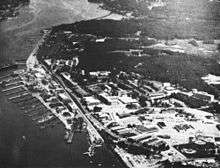Naval Submarine Base New London
| Naval Submarine Base New London | |
|---|---|
| Groton, Connecticut, United States. | |
 | |
| Type | Military base |
| Site information | |
| Owner |
|
| Controlled by |
|
| Site history | |
| In use | 1868-present |
Naval Submarine Base New London is the United States Navy's primary East Coast submarine base, also known as the "Home of the Submarine Force". It is located in Groton, Connecticut.
History
In 1868, the State of Connecticut gave the Navy 112 acres (0.5 km²) of land along the Thames River in Groton to build a Naval Station. Due to a lack of federal funding, it was not until 1872 that two brick buildings and a "T" shaped pier were constructed and officially declared a Navy Yard. In 1898, Congress approved a coaling station be built at the Yard for refueling small naval ships traveling through the waters of New England. The Navy Yard was first used for laying up inactive ships. The Congressional appropriations were small and the Navy had little need for the Yard, which was actually closed from 1898 to 1900 and its personnel reassigned. This new yard was primarily used as a coaling station by Atlantic Fleet small craft. It is located in the towns of Groton and Ledyard. By 1912, oil replaced coal in warships and again the Yard was scheduled for closure and the land relinquished by the Navy.
The Navy Yard was spared permanent closure in 1912 by an impassioned plea from local Congressman Edwin W. Higgins of Norwich, who was worried about the loss of Federal spending in the region. Within six years, the Federal government would spend over a million dollars at the Yard. On 13 October 1915, the monitor Ozark, a submarine tender, and 4 submarines arrived in Groton. With the war effort in Europe and the Atlantic in full swing, additional submarines and support craft arrived the following year and the facility was named as the Navy's first Submarine Base. The first Commander of the Yard was retired Commodore Timothy A. Hunt, who was recalled up to service. Living in New Haven, Commodore Hunt used the Central Hotel on State Street, New London when in town to attend to Yard duties on an “as needed” basis. Despite being physically located in the Town of Groton, the name New London became associated with the Navy Yard because the base had its main offices and housing in New London. Following World War I, the Navy established schools and training facilities at the base.
The first diesel-powered US submarine, USS E-1 (SS-24), was commissioned in Groton on February 14, 1912, Lieutenant Chester W. Nimitz in command.
On June 21, 1916, the Navy Yard changed forever as Commander Yates Stirling, Jr. assumed the command of the newly designated Submarine Base, the New London Submarine Flotilla, and the Submarine School.
The Base property expanded during the latter part of World War I. Congress approved over a million dollars for Base real estate and facilities expansion. By the end of the war, 81 buildings had been built to support 1400 men and 20 submarines. With victory in hand, the land expansion of the Base was slowed through much of the 1920s. However, the Great Depression of the 1930s saw an expansion and enhancement of the physical plant of the Base. President Franklin Roosevelt created a series of Federal Government employment programs that contributed significantly to the Submarine Base. Over 26 high quality warehouses, barracks and workshops were built at the base under these Federal job-spending programs. The second largest expansion of Submarine Base New London occurred during World War II, when it grew from 112 acres to 497 acres. The Submarine Force leaped in size, and the Base accommodated thousands of men to service the growing combat fleet. Immediately after WWII the Submarine Force was significantly reduced and many famous submarines were sent into storage. Most of the World War II fleet was sold for scrap metal during the early 1960s.

From 1930 to 1994 the most recognizable structure on the base was the 100-foot-tall Escape Training Tank. Generations of submariners learned to escape in up to 80 feet of water using buoyant ascent, and were trained in the use of the Momsen lung or Steinke hood. In 2007 the Escape Training Tank was replaced by the Submarine Escape Trainer, which has two types of escape trunks in up to 40 feet of water. The Steinke hood was replaced by the Submarine Escape Immersion Equipment in the 2000s.[1]
On January 21, 1954 the first nuclear-powered submarine, the USS Nautilus, was launched from Groton. USS Nautilus became the first vessel to transit the North Pole during an historic trip across the Arctic in 1958. It was retired from service in 1980. In 1982 the Nautilus was designated a National Historic Landmark in Groton. It is permanently moored south of the main gate, attached to the U.S. Submarine Force Museum. Self-guided tours are available to the public every day except Tuesday. The museum's collections include more than 33,000 artifacts, 20,000 significant documents and 30,000 photographs.
As homeport to sixteen attack submarines and neighbor to a major submarine construction yard, General Dynamics' Electric Boat Division, all Officer and Enlisted submariners with the exception of nuclear trained Electronics Technicians (ETs), Electrician's Mates (EMs), and Machinist's Mates (MMs), are stationed at Groton for training, on board an attack submarine or with a pre-commissioning crew for a new submarine. Enlisted sailors attending sub school will first go through Basic Enlisted Sub School (BESS), an 8-week program that teaches the rigors of undersea life. BESS includes training in shoring, patching leaks and ruptured pipes, firefighting, and boat handling techniques. After BESS, sailors will either go to a boat or to follow-on schools. Schools include BMS, AUXPAC, ATT, TCNO, or an A school, depending on their rating. The A Schools housed at NAVSUBASE NLON are SECF, SCERF, AUXPAC, TM "A".
- SECF is the combined "A" School for Sonar Technician Submarines (STS), Navigation Electronics Technician (ET NAV), and Firecontrol Technicians (FT).
- SCERF is the Submarine Communications Electronic Rating Field and it trains Communication Electronic Technicians (ET Comms) otherwise known as Radiomen.
- AUXPAC transforms new submariners into some of the finest mechanics in the U.S. Navy, as Auxiliary Machine Mates, or A-Gangers (MM-A).
- TM "A" trains Torpedo's Mates (TM/MMW).
The main base occupies more than 687 acres (3 km²) plus over 530 acres (2 km²) of family housing and is homeport to fifteen attack submarines. The base also supports more than 70 tenant commands including, Commander Navy Region Northeast (CNRNE), Naval Submarine School (NAVSUBSCOL), Naval Submarine Support Facility (NSSF), three Submarine Squadron staffs, and the housing and support facilities for more than 21,000 civilian workers, active-duty service members and their families.
Naval Submarine Medical Research Laboratory
Naval Submarine Medical Research Laboratory's mission is to protect the health and enhance the performance of United States War Fighters through focused submarine, diving, and surface research solutions.[2]
Base Realignment and Proposed Closure, 2005
On 13 May 2005, the Pentagon recommended that the base be closed. After review, the Base Realignment and Closure commission voted on 24 August 2005 to strike New London from the list of possible closures, thus allowing the base to remain open.
Homeported boats
See also
| Wikimedia Commons has media related to Naval Submarine Base New London. |
References
- ↑ www.navy.mil "Submarine Escape Trainer Completed", 2 November 2007, retrieved 11 February 2014
- ↑ Daniel, JC & Lamb, J (2005). "NSMRL: A Small Command with A Huge Presence for the Submarine Force". US Naval Submarine Medical Research Laboratory Technical Report. NSMRL-TR-1239. Retrieved 2013-03-20.
External links
- Official website
- NSB New London website
- Militarynewcomers
- Naval Vessel Register
- U.S. Navy Submarine Force Museum — Official home of USS Nautilus (SSN-571)
- Navy Basic Enlisted Submarine School
- Historic American Engineering Record (HAER) No. CT-37-A, "U.S. Naval Submarine Base, New London Submarine Escape Training Tank, Albacore & Darter Roads, Groton, New London County, CT", 53 photos, 3 measured drawings, 32 data pages, 5 photo caption pages
Coordinates: 41°23′53″N 72°05′13″W / 41.398115°N 72.086964°W

